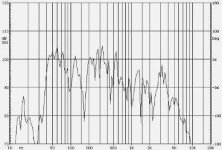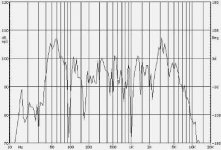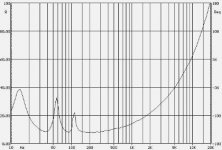When you are using a current amplifier it is imperitive that the speaker has a flt impedance curve (ie Elsinore), low Qms full-ranges in an appropriate enclosure, or a FR driver that is designed for a high output impedance amplifier (ie most Fostex FExx6). A current amp can also be used in a multi-amp situation where the bandwidth of the driven driver has a flat impedance.
With a current amp (or one approaching such, ie most SE tube amps), a portion of the speaker’s impedance curve is convolved with its frequency response (when measured with a voltage amp).
The XO & the system resonances are the most common places for significant pertebation of the impednce.
When choosing to use a current amplifier one gas to carefully match the speakers that go with it.
dave
dave
With a current amp (or one approaching such, ie most SE tube amps), a portion of the speaker’s impedance curve is convolved with its frequency response (when measured with a voltage amp).
The XO & the system resonances are the most common places for significant pertebation of the impednce.
When choosing to use a current amplifier one gas to carefully match the speakers that go with it.
dave
dave
Most of my tube amplifiers do not use negative feedback.
Well, let me clarify that, it is not 100% true.
They all use output transformers, so let us just consider mid band audio frequencies.
As examples of my amplifiers:
Triode outputs follow that rule (no negative feedback).
Triode wired Beam Power outputs follow that rule (well, that is 100% local plate to screen negative feedback, but it is one of the shortest local negative feedback loops that are possible; nothing global about it).
Ultra Linear Beam Power outputs follow that rule (well, that is 43% [or 50%] local negative feedback from plate to screen, a fairly short local loop; nothing global about it).
Starting with those amplifiers for the discussion,
I do not consider the amplifiers to be a Current source.
And, I do not consider the amplifiers to be a Voltage source.
Instead, I consider them to be:
Either a Voltage source in series with a resistor.
Or a Current source with a resistor across the current source.
All of my amplifiers have Moderate damping factors.
They work reasonably well with all of the various loudspeakers that I own.
I think that is a fairly accurate analysis of the output stage of my amplifiers.
Please give me your comments on the above statements . . .
Well, let me clarify that, it is not 100% true.
They all use output transformers, so let us just consider mid band audio frequencies.
As examples of my amplifiers:
Triode outputs follow that rule (no negative feedback).
Triode wired Beam Power outputs follow that rule (well, that is 100% local plate to screen negative feedback, but it is one of the shortest local negative feedback loops that are possible; nothing global about it).
Ultra Linear Beam Power outputs follow that rule (well, that is 43% [or 50%] local negative feedback from plate to screen, a fairly short local loop; nothing global about it).
Starting with those amplifiers for the discussion,
I do not consider the amplifiers to be a Current source.
And, I do not consider the amplifiers to be a Voltage source.
Instead, I consider them to be:
Either a Voltage source in series with a resistor.
Or a Current source with a resistor across the current source.
All of my amplifiers have Moderate damping factors.
They work reasonably well with all of the various loudspeakers that I own.
I think that is a fairly accurate analysis of the output stage of my amplifiers.
Please give me your comments on the above statements . . .
Last edited:
I still believe that no-feedback PP pentode amplifier is a good current source.
A mediocre 8K : 8 Ohm PP transformer has reflected secondary inductance of 100 mH. It's impedance at the lowest band frequency of 100 Hz is 63 Ohms, or 8x speaker's nominal impedance. So, the amp with this transformer is a pretty good current source at 100 Hz, and even better one at higher frequencies. A better transformer with more primary inductance will make the amp even better current source.
I don't like the whole concept of UL for two reasons. One, for the most linear pentode operation, static Ua should be much higher than Ug2, and this is extremely difficult to implement in practice for UL. Second, let the damned screen do what it was meant to do.
A mediocre 8K : 8 Ohm PP transformer has reflected secondary inductance of 100 mH. It's impedance at the lowest band frequency of 100 Hz is 63 Ohms, or 8x speaker's nominal impedance. So, the amp with this transformer is a pretty good current source at 100 Hz, and even better one at higher frequencies. A better transformer with more primary inductance will make the amp even better current source.
I don't like the whole concept of UL for two reasons. One, for the most linear pentode operation, static Ua should be much higher than Ug2, and this is extremely difficult to implement in practice for UL. Second, let the damned screen do what it was meant to do.
If we look historically, old radios with such things as field coil speakers, single ended and push pull output stages, no negative feedback, and Pentode / Beam Power output tubes, they were reasonably effective "current sources".
The speaker Q was controlled in order to work well with those amplifiers and the cabinet's open back; some took advantage of the slight rise at bass frequencies. Also, the voice coil inductance which gave rising impedance at high frequencies worked well with the current source amplifiers, because at the same time the speaker high frequency mechanical response was rolling off, the current was flat, instead of rolling off due to the voice coil inductance's rising impedance.
And, if there was leakage reactance from the primary to the secondary, as the frequency increased, the plate swing also increased, helping to make up for the high frequency rolloff.
Quite genius those engineers of old!
As to UL, optimum performance is an arguable point.
I do not always design for max power output, nor for maximum efficiency, I design for other things, finesse, and simplicity too.
Be willing to make the tradeoffs that you personally want to make.
Tradeoffs, Tradeoffs, Tradeoffs.
This is not the Tacoma Narrows Bridge, and it is not the San Francisco Golden Gate Bridge.
Design and Build your own Bridge.
The speaker Q was controlled in order to work well with those amplifiers and the cabinet's open back; some took advantage of the slight rise at bass frequencies. Also, the voice coil inductance which gave rising impedance at high frequencies worked well with the current source amplifiers, because at the same time the speaker high frequency mechanical response was rolling off, the current was flat, instead of rolling off due to the voice coil inductance's rising impedance.
And, if there was leakage reactance from the primary to the secondary, as the frequency increased, the plate swing also increased, helping to make up for the high frequency rolloff.
Quite genius those engineers of old!
As to UL, optimum performance is an arguable point.
I do not always design for max power output, nor for maximum efficiency, I design for other things, finesse, and simplicity too.
Be willing to make the tradeoffs that you personally want to make.
Tradeoffs, Tradeoffs, Tradeoffs.
This is not the Tacoma Narrows Bridge, and it is not the San Francisco Golden Gate Bridge.
Design and Build your own Bridge.
Last edited:
All best current amps I have seen in the past were OTL, both tube and SS technology. However, from what I could see (they were commercial products) they were not standard SE or PP output stages. Zout in the 200K (valve) to 1 Meg (SS) range. Unfortunately that company is out of business.
Which company built those amps? And are any of their designs available for us to play with?
Glad you like it
I borrowed it from Jan L. A. van de Snepscheut and framed it for my desk when I qualified as an engineer in 1981. Apparently it dates from the 19th century: see https://quoteinvestigator.com/2018/04/14/theory/
I borrowed it from Jan L. A. van de Snepscheut and framed it for my desk when I qualified as an engineer in 1981. Apparently it dates from the 19th century: see https://quoteinvestigator.com/2018/04/14/theory/
Standard vacuum tube amplifiers with output transformers are constant power sources, regardless of pentodes or triodes in the output stage. The presence of an output transformer drops the Zout in the 50-150R for pentodes and 2-5 ohm for triodes, typically. But it's not just that, their behaviour is dictated by their curves. Standard output stages do not behave like constant current sources at all in terms of power delivery.
Which company built those amps? And are any of their designs available for us to play with?
It was called Ultrasound. No design available, especially because they used custom transistor for their amps. The tube amp I think it used television tubes but their circuit is unknown.
With a current amp (or one approaching such, ie most SE tube amps), a portion of the speaker’s impedance curve is convolved with its frequency response (when measured with a voltage amp).
dave
With a true current drive you only get some unavoidable (small) peak at the woofer resonance which normally disappears in normal use because the room acoustics dominates. Other than that, if the crossover is correct if multiway, it only follows the inductive behaviour of the drivers at higher frequency (equalization). For this latter aspect, with some drivers, a tweeter is not necessary....
The advantage of the current drive (but also the disadvantage if not right) is that it relies on speaker self damping. This means that on the impulse response there will be an overshoot (irrelevant really) but cleaner and faster response despite the damping factor of the amplifier is (ideally) zero!
Proper current drive technology is expensive for both speakers and amps. That's the reason why is not common.
Standard vacuum tube amplifiers with output transformers are constant power sources, regardless of pentodes or triodes in the output stage. The presence of an output transformer drops the Zout in the 50-150R for pentodes and 2-5 ohm for triodes, typically. But it's not just that, their behaviour is dictated by their curves. Standard output stages do not behave like constant current sources at all in terms of power delivery.
As long as Zout >> Zloudspeaker it is essentially current drive, because the current is mainly set by the amplifier and the loudspeaker's impedance hardly has any impact on it.
Feed a typical tube amp with a the typical loudspeaker load and you will see that both voltage and current change in the attempt to keep power constant. It's the way they work. To get true current amp Zout needs to be at least Kohms or better. However not cheating with series resistors, it has to be the internal amp impedance.....
Advantages and disadvantages
I don't see that as an advantage. That is a disadvantage, which advocates of voltage-drive usually remember to point, emphasizing damping factor, "controlled" cone movement, etc.
The real advantage of the current-drive is: less distortion. Most realiably that may be achieved if there is one amplifier per each speaker driver, and no passive reactionary circuits in between. Also, if two or more similar drivers are used to reproduce the same signal, they should be series connected to ensure exactly same current through voice coils.
The main disadvantage of the current-drive is the bass resonance, but it may be cured by damping the speaker enclosure, and many useful methods and solutions are available.
The advantage of the current drive (but also the disadvantage if not right) is that it relies on speaker self damping.
I don't see that as an advantage. That is a disadvantage, which advocates of voltage-drive usually remember to point, emphasizing damping factor, "controlled" cone movement, etc.
The real advantage of the current-drive is: less distortion. Most realiably that may be achieved if there is one amplifier per each speaker driver, and no passive reactionary circuits in between. Also, if two or more similar drivers are used to reproduce the same signal, they should be series connected to ensure exactly same current through voice coils.
The main disadvantage of the current-drive is the bass resonance, but it may be cured by damping the speaker enclosure, and many useful methods and solutions are available.
What people advocate is just sponsoring what they have done. The HiFi world is anything but scientific.....
The damping control only works as intended IF the loudspeaker is linear. Because no driver behaves perfectly as a linear device then a proper current drive can be better because the non-linear part is not "amplified". But it's not the amplifier you posted in your opening post.
Distortion is what you get with non linear behaviour.
The bass resonance is not a problem at all. It#s just metropolitan legend. Ultrasound made 2 kinds of loudspeakers: their flagship using double transmission line and the rest was bass reflex. I listened to those loudspeakers many times and they were spot on, especially with current drive. The Alias model also won a price in the US, the EISA 2001-2002.
The damping control only works as intended IF the loudspeaker is linear. Because no driver behaves perfectly as a linear device then a proper current drive can be better because the non-linear part is not "amplified". But it's not the amplifier you posted in your opening post.
Distortion is what you get with non linear behaviour.
The bass resonance is not a problem at all. It#s just metropolitan legend. Ultrasound made 2 kinds of loudspeakers: their flagship using double transmission line and the rest was bass reflex. I listened to those loudspeakers many times and they were spot on, especially with current drive. The Alias model also won a price in the US, the EISA 2001-2002.
To show the performance of their current drive, Ultrasound did not use their speakers. The one below is a reasonably economical 8" with whizzer cone in bass reflex. On the left frequency response if voltage driven, in the middle if current driven and on the right impedance curve. Which one looks better?
Attachments
45,
Most of the impedance curve is classical for a single full range driver.
Dual impedance peaks (either side of the port tuning).
Rising impedance due to voice coil inductance.
But . . . what is the cause of the resonance at 15Hz?
I never saw that 3rd resonance before on a full range driver.
Most of the impedance curve is classical for a single full range driver.
Dual impedance peaks (either side of the port tuning).
Rising impedance due to voice coil inductance.
But . . . what is the cause of the resonance at 15Hz?
I never saw that 3rd resonance before on a full range driver.
- Home
- Amplifiers
- Tubes / Valves
- Current-drive by a valve amplifier


